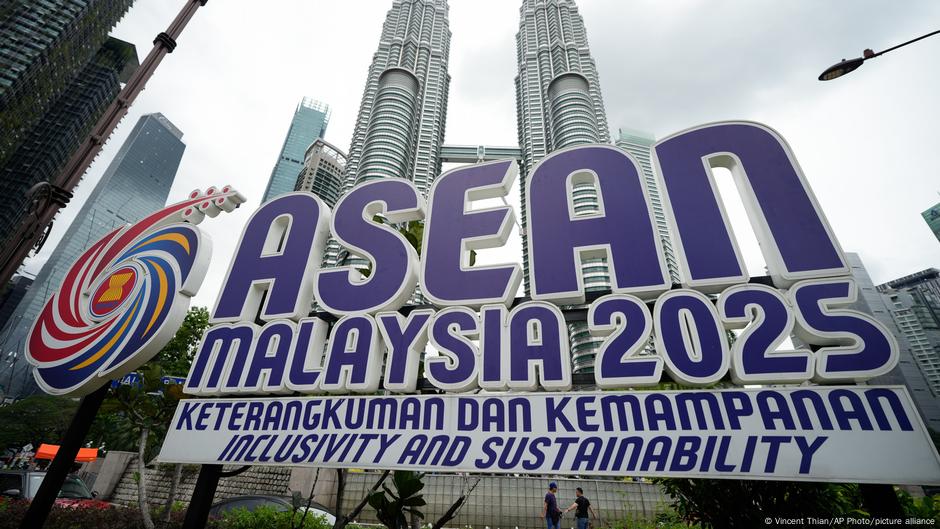There will be a lot to discuss at the summit of the Association of Southeast Asian Nations. Regional economic integration, environment and digital development as well as peace, security and regional stability will be on the agenda of the three-day meeting starting on Sunday in the Malaysian capital Kuala Lumpur.
More than 30 heads of state and government from the 10 member states of the association, commonly known as ASEAN, are invited. US President Donald Trump is also among those invited from outside the bloc.
Trump mainly wants to attend the ceremony where Thailand and Cambodia will sign the recently signed peace agreement. The agreement followed a five-day battle triggered by the border dispute, partly due to pressure from Trump, who threatened economic consequences if both countries did not resolve the issue.
This incident showed how much influence America has in the Asia Pacific region. This is important because of the increasing rivalry between the US and China in this region.
Part of the geopolitical competition between the two superpowers involves Taiwan: China believes the island belongs to it, but the US supports the status quo with Taiwan as a self-governing democracy.
The two superpowers are also quarreling over the existing arrangement in the South China Sea. Tensions center on China, Taiwan and Southeast Asian countries such as the Philippines, Vietnam and Malaysia staking claims to each other in the resource-rich waters. China’s massive “nine-dash line” claim covering nearly 90% of the ocean violates international law and the exclusive economic zones of other countries.
forced to choose a side
Felix Hayduk, head of the Asia Research Division at the German Institute for International and Security Affairs, says that trade tensions between China and the US are also increasing and this is further increasing the rivalry between the two countries in Southeast Asia. This means that, apart from the official agenda, there is bound to be a lot of talk about US-China tensions and the difficult situation ASEAN countries are facing due to these tensions. Many people are being pressured to choose between one superpower or another.
This is true, Heiduk confirms, especially when it comes to areas like security, business and technology. He said, “Ultimately, this argument boils down to a kind of zero-sum game. You have to be in one camp or the other.”
ASEAN countries are trying to avoid being forced to make such a choice.
It is also becoming difficult for America or China to persuade them to take a side. An analysis by the magazine, Diplomat, Turns out that many politicians in the region are frustrated with Trump’s tariff policies. These have impacted America’s close allies as well as distant allies in the region.
Given the current sensitivities over control over various parts of the South China Sea, maritime border ASEAN countries are particularly vulnerable to bold claims of regional dominance. They have watched with surprise and concern Trump’s demands for control over the Panama Canal, Greenland and Canada, fearing that if the inviolability of the US’s national borders could be questioned in this way, it would embolden China to make similar claims on its territory.
according to DiplomatThis has created a different perception about America in Southeast Asia.
America is not seen as a reliable partner
Andreas Uffen, a senior expert at the German Institute for Global and Area Studies, or GIGA, in Hamburg says many ASEAN countries no longer see the US as a reliable partner – especially because of growing Chinese belligerence in the region.
according to a report At the East Asia Forum, an international forum for policy on the region, China is claiming outlying areas and building artificial islands for military purposes, for example near the Spratly and Paracel islands. The report also said that China is developing resources in disputed areas and by doing so is interfering with maritime transportation.
ASEAN countries are reacting to China’s aggression in different ways. Some economically weak people have no option but to bear it.
“Myanmar, Cambodia and Laos, for example, are closely tied to China economically and in terms of security and defense policy,” Heiduk said. “Along with this comes the fact that they do not have close defense and security relations with the US.”
a difficult balancing act
Larger and richer countries try to create a greater balance by attempting to cooperate with both countries as much as possible.
For example, the Philippines cooperates closely with the US on defense and security, with the two countries signing a mutual defense treaty in 1951. Heiduk points out that this has become increasingly important given China’s growing military presence in the South China Sea.
“However, that military cooperation does not prevent the Philippines from maintaining close economic ties with China,” Heiduk said. “China is one of the Philippines’ three most important trading partners and is also a major investor there.”
Giga analyst Ufen says Indonesia is also trying to avoid choosing a side.
“Indonesia sometimes cooperates with China and sometimes with the United States,” he said. However, in terms of defense and arms purchases, Indonesia orients itself towards Western partners. “Because if an armed conflict ever arose, it would most likely be in the South China Sea with China,” explains Uffen. The US also conducts major military exercises with Indonesia.
But none of this prevents Indonesia from pursuing economic ties with China. “Economically, Indonesia and China work very well together,” says Uffen.
This article was originally written in German.






Leave a Reply